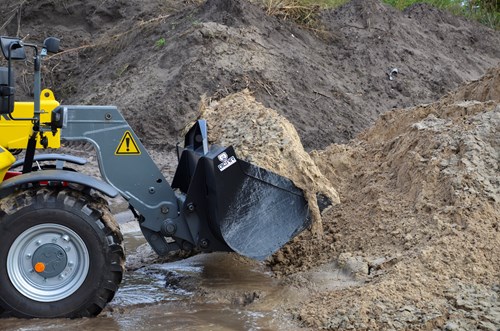
Selection tips
SELECTION TIPS
Choose your perfect match
BEAR Attachments offers more than 500 unique attachments, each with its own specifications. When choosing the right attachment it is important that it is clear in advance what kind of work must be performed with the attachment and what the performance / specifications of the machine are. The tipping load of the machine and, among other things, the specific weight of the materials are important for selecting the right bucket. The weight of the attachment must of course be included in this calculation. When selecting attachments with one or more hydraulic functions, it is important that the required function is also available on the machine. For attachments equipped with a hydraulic motor, the machine must meet the required liters per minute (working hydraulics) with the required working pressure.
EXPLANATION OF TECHNICAL TERMS
Hardox vs "standard steel"
Hardox material is characterized by a uniform flatness, high hardness and high strength. The weight of the Hardox steel is effectively reduced. This is possible because a thinner plate thickness can be used due to the high plate strength. Hardox® wear plates don't lose their impact resistance even at low temperatures. Because the wear resistant plate also has very good welding and processing properties, future repairs to wearing parts are also possible without any problems. By choosing wear resistant steel with a high strength and high hardness, the weight of the construction can be reduced by up to 15%. In addition, increasing the hardness by 50 Brinell extends the life of the attachment by 50 to 80 percent. All buckets of BEAR Attachments are equipped with Hardox wear parts such as the knife inserts in the side walls.
Content and ISO content
With our buckets we describe the content as if it would be filled flat full with water. The displayed content of the bucket is an ISO content, which means a full bucket with a cup on it as shown in the image below.
The maximum size can be calculated as followed:
Tipping load of the machine = weight of the bucket + (specific weight x ISO content)
What is tipping load
The capacity of the machine is often expressed in tipping load. The tipping load is the maximum load with which you can still work safely. Many manufacturers display the tipping load in different machine positions. You can find this information in the manual or on the manufacturer’s website.
EXPLANATION HYDRAULIC OPTIONS:
Double acting function
This is a function that machines are often equipped with 1x mechanically as a standard and is also called the 3th function. This function consists of 2 valves which you operate by means of a lever to determine the flow direction of the oil on both sides. With this function you can, among other things, operate attachments with a clamp such as a pelican bucket or manure clamp, but also attachments with a hydraulic motor such as a sweeper. Some attachments require 2 or more double acting functions like a high tip bucket with clamp or a weed brush with hydraulic arm adjustment.
Leakage oil connection
This is a connection that is often required with attachments such as mowers. The leakage oil connection on the hydraulic motor prevents too much pressure on the hydraulic motor internally, causing it to leak. A leakage oil line carries this overpressure oil/leakage oil to the oil tank of the machine.
Free return
A return line sends the oil directly back into the oil tank instead of through the valve block. To prevents back pressure and resistance which causes the oil to heat up unnecessarily. By using a free return, the attachment can only be controlled in a single-acting manner. This is ideal for high oil flow attachments such as mowers and sweepers. By using a “free return” a higher speed can also be achieved with a mower for example.
Detent
This is a function on a mechanical valve where you can lock the handle and open the oil flow. It means you don’t have to hold the lever constantly when working with a sweeper or mower, for example.
Proportional function
This is an electronically controlled hydraulic function in which the oil flow is controlled in a dosed manner, often via a scroll function on the joystick. These options are often offered with a memory function. It allows the oil flow to be locked and activated with 1 push of a button. These are functions that are often used when precise clamping or rotation is required. The memory function is ideal for sweeping or brushing, for example.
High flow
This is a term which is used when the standard working hydraulic pump is coupled to an optional extra (tandem) hydraulic pump. By linking these together you get the maximum oil flow from the machine that is needed for specific attachments where a high oil flow is required. This includes snow blowers, straw blowers, etc.